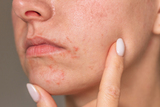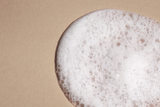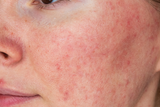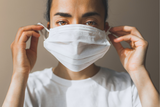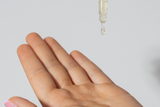Easy Peasy You
History of sunscreen: why our ancestors didn't need it, but we do
Posted by Anne-Katrin Endler on
The topic of sun protection is divisive and surrounded by myths.
Some people are always careful to apply the right amount of sunscreen and reapply it every two hours. Others look for natural alternatives, because sunscreen also brings various problems with it. That's why our guest author, Anne-Katrin Endler, takes a look at the history of sunscreen this time.
One of the myths about sunscreen is that our ancestors didn't get skin cancer even without it. This isn't wrong; in fact, it's a fact. However, the reverse isn't true. The claim that because our ancestors didn't get skin cancer without sunscreen, we don't need it today is false.
Before the invention of sunscreen
But first of all: Why didn't people get skin cancer in the past? The simple reason is that they didn't live as long as we do today. Life expectancy in 1835 was only 33 years. So, before people could develop cancer, they usually died of other illnesses. According to the German Cancer Society, skin cancer now occurs on average between the ages of 75 and 79. This is an age that many people have only reached in the last few decades. From the mid-19th century onward, hygiene improved and medicine made great strides. The pathogens of tuberculosis, anthrax, and cholera were identified, drinking water was purified, and vaccinations against epidemics were introduced. Cancer, as a major disease, only then emerged on the medical stage. Of course, cancer has always existed – archaeological excavations have even confirmed this. However, for a long time, it couldn't be detected with the available diagnostic methods. And given people's lifespans, it simply wasn't a widespread phenomenon.
So we now know that cancer wasn't the greatest threat to our ancestors. Nevertheless, they protected themselves from the sun – at least those who could afford it. This was primarily due to the prevailing beauty ideal: a noble paleness. This was also a sign of distinction from the working classes, whose skin was naturally much more exposed to the sun. Even in antiquity, oils such as olive oil, rice bran, jasmine, or lupin were reportedly used for sun protection. You can learn more about the advantages and disadvantages of facial oils here . Zinc pastes were also mixed and applied to the skin – a kind of precursor to today's mineral sunscreens. However, the best and most common sun protection was clothing, parasols, and staying in the shade. Along with the beauty ideal came moral standards that, for a long time, prohibited showing too much skin. At the beginning of the 20th century, dress codes were still in effect on the beaches of German seaside resorts. It would be several more decades before the bikini was invented.

When was the first sunscreen invented?
In the 1920s, outdoor activities became popular. Fashion also underwent a transformation. More skin was shown at the beach, increasing the risk of sunburn. The time was ripe for the first sunscreen. Bayer subsidiary Drugofa was the first company to launch Delial ointment in Germany in 1933 (below you can see an old Delial advertisement).

Ambre Solaire by L'Oréal founder Eugène Schueller (1936) and Piz Buin by Austrian chemistry student Franz Greiter (1948) followed. The first sunscreens were primarily intended to prevent sunburn, not the increasingly fashionable tan. Incidentally, fashion icon Coco Chanel is said to be responsible for this new trend, having returned from a boat trip on the Mediterranean with a deep tan – not entirely by choice, as legend has it she forgot her parasol. The fact remains, however, that the ideal of beauty was changing, and a "healthy tan" now seemed desirable. It wasn't just considered beautiful; tanned skin also became a sign of wealth, indicating that one could afford a vacation. Since Germany's economy began to recover after World War II, people increasingly sought their place in the sun in southern Europe.
Since when has the sun protection factor existed?
The sun protection factors (SPF) of the first sunscreens were meager. The product Piz Buin, for example, had an SPF of 2. Other products likely performed similarly. Incidentally, the SPF was defined by Franz Greiter in 1962. From the mid-1970s onward, it was increasingly indicated on sun protection products, but remained low for a long time. According to Stiftung Warentest (a German consumer organization), an SPF of 4 was the most popular with consumers well into the 1980s. An SPF of 15 was considered a sunblock. Only with the discovery of the ozone hole in the mid-1980s and the increasing incidence of skin cancer did a shift toward higher SPFs slowly begin.

Is sunscreen harmful?
Today we know more than ever before about the dangers of sun exposure. Besides UVB rays, we're also aware of the risks posed by UVA rays and are beginning to learn about blue light. We know how to protect ourselves and have more sunscreens to choose from than ever before. They're also much more affordable than they used to be and have improved formulations. In addition to chemical filters, we can also opt for mineral ones. Thanks to the internet, we can scrutinize the ingredients and choose only the products we want on our skin. We don't need to be chemists to do this. We can use apps, read product tests like those from Stiftung Warentest (a German consumer organization), or consult, for example, the Xeno sun protection guide . This guide not only discusses the ingredients but also provides tips on skin compatibility for sensitive skin. You can also find countless sunscreen reviews on social media. It's never been so transparent.
Get our free sun protection guide for sensitive skin here.
By registering, you confirm our Privacy Policy .
You will receive a confirmation email shortly. Confirm in the email that we may send you messages and download the sun protection guide.
At the same time, many people are more concerned than ever that sunscreen could harm us. Is there any truth to this?
Many people are worried about their vitamin D intake and have concerns about the ingredients in sunscreens. This is understandable. We need vitamin D for our health, and unfortunately, some questionable UV filters and ingredients are still being used. We also need to consider the impact of sunscreens on our environment (think coral bleaching). But does this mean we have to go back to basics and resort to the sun protection strategies of our ancestors? Yes, if it's about protecting ourselves with clothing, using sun hats and umbrellas, and seeking shade. Yes, if it's about rethinking beauty ideals and leaving behind the "healthy tan." No, if it's about using pure plant oils instead of modern sunscreens with safe filters and reliable sun protection factors. And no, if it's about making your own sunscreen.
Remember to remove the sunscreen in the evening with a gentle facial cleanser .
Plant-based oils like coconut or olive oil have a sun protection factor (SPF) of approximately 7. Other oils have even lower levels. Dermatologists recommend an SPF of at least 30. As a reminder, the SPF indicates how much longer you can stay in the sun while using sunscreen. If a person has a natural sun protection time of about ten minutes, they can stay in the sun for 70 minutes with SPF 7 before getting sunburned. That won't get you very far in the summer. With SPF 30, it's 210 minutes, and with SPF 50, 350 minutes. The German Federal Office for Radiation Protection advises only using up to 60% of your natural sun protection time. With SPF 7, that would give you 42 minutes. It would also be difficult to apply the recommended amount of 2 mg per square centimeter of skin with pure oil. That's about 4 heaped tablespoons for the whole body. Hard to imagine with pure oil.
Conclusion
A look at the history of sunscreen shows that people have always used whatever products were available at the time. Our grandparents would certainly have gladly traded their heavy, sticky pastes for ours. Perhaps our parents and we would have been spared a sunburn or two as children if we had applied sunscreen regularly from an earlier age. So let's appreciate the variety and choose the sunscreen we like and use frequently. Because the best sun protection is the one we enjoy using.
- Tags: Hautpflege, Sonnenschutz
← Older Post Newer Post →
0 comments



